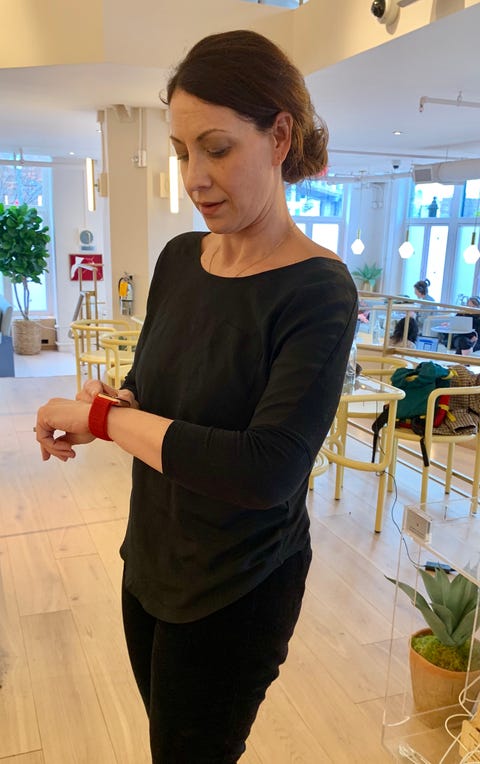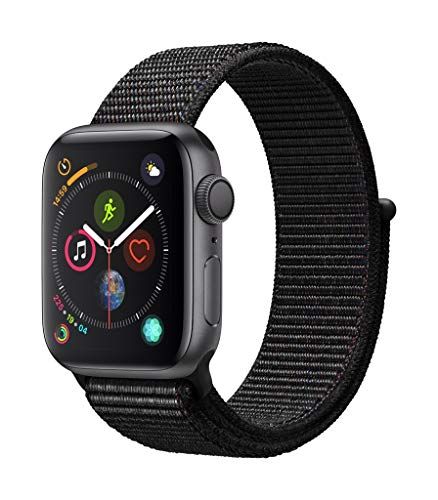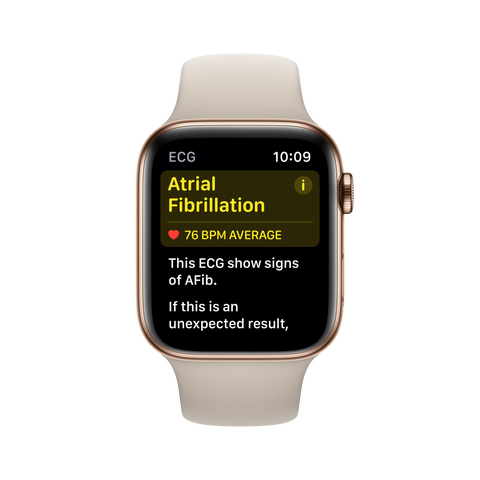
Elizabeth Bacharach
As Women’s Health‘s health editor, I’ve been geeking out over the new health and fitness features of the Apple Watch Series 4 since it came out in September. But two of the most exciting—an app that can take an on-demand ECG (electrocardiogram) readings and a irregular-heartbeat alert—didn’t launch until today as a part of a free update to watchOS 5.1.2. I got a sneak peek of these functions ahead of their public rollout, and guys, they’re seriously game-changing.

Inspired by users who said the watch’s older heart-rate monitoring feature helped them catch dangerously irregular or abnormal heart rates, Apple spent the last few years working with researchers at Stanford Medicine (and more than 2000 patients) to develop new technology to identify a potentially serious heart condition called atrial fibrillation. Apple built electrodes into the watch’s back crystal and digital crown (a.k.a. side dial). When you touch your finger to the latter, it creates a circuit that measures electrical signals from your heart.
AFib, as it’s called by docs, is a heart disorder in which the two upper chambers of the heart (the atria) beat rapidly and irregularly. AFib increases the risk of stroke and heart attack, but it often goes unnoticed because many people don’t experience symptoms (those who do might feel a racing pulse, chest pain, or shortness of breath).
Taking an ECG reading with the watch is incredibly easy. Just launch the ECG app and hold your finger to the digital crown. It only takes 30 seconds and the ability to sit still; fidgeting—or as I discovered, trying to take a reading on a jostling bus—will mess up the results.

Elizabeth Bacharach
I ran the test a few times (in the name of journalism; there’s no real need to test unless your heart is thumping or fluttering). My heart felt fine, so I wasn’t surprised that the watch showed I was in Sinus (a.k.a. normal) Rhythm. Reassuring!

Elizabeth Bacharach
If the watch had picked up AFib, I would have gotten a notice like this:

AppleCourtesy of Apple
I also would have gotten a PDF of the results in the Health app to share with my doctor—because you can bet I would’ve panicked and called her, ASAP.
Even though older women are at a higher risk for AFib (the average age for developing it is 75), it can strike young women, too, particularly those who have sleep apnea, an overactive thyroid, or diabetes, according to the National Coalition for Women with Heart Disease . And while having high blood pressure or heart disease is the biggest risk factor for AFib, chugging too much caffeine or being under tons of stress can trigger it, too, notes the American Stroke Association.
In my opinion, this is the watch’s biggest win, and here’s why: Have you ever felt something weird happening in your body…only to feel total normal the second you get to the doctor? You sit there in your paper gown feeling like a time-wasting hypochondriac (“I swear, my right eye has been twitching all morning!”), while your doctor struggles to make an accurate diagnosis.
With the PDF generated by the ECG app, your physician can see what your heart was doing in the exact moment something felt off, instead of making you wear a monitor for days, even weeks, hoping to pick up another episode.
The watch’s other tool for detecting AFib is the irregular heart rhythm notification. While you go about your day, the watch sporadically checks your heart’s rhythm. If it clocks five or more consecutive irregularities over a minimum of 65 minutes, it pings you. I couldn’t really test this function (because if it doesn’t pick up any wonky patterns, you don’t receive any notifications), but it’s nice to know that it’s there in the background, keeping watch (no pun intended) over my ticker.

The irregular heart rhythm notification functionality is available in Series 1 watches or later, using the same sensor that picks up your pulse during a workout. But in case you’re wondering, simply having an elevated heart rate during your sweat sesh won’t cause an alert. This tool is for collecting data about your heart health, not how hard you’re crushing it at the gym or on a run. For that, you’re going to want to just keep using the heart rate monitor function.
This tech is impressive. In fact, it’s so legit it’s approved by the American Heart Association and the Food and Drug Administration. But it only replicates a single-lead ECG reading (fun fact: the one your doc wires you up to is has 12 leads, to measure the heart’s activity from 12 different angles).
This is why the watch can only detect AFib, not other heart health issues, like heart attack or stroke. Meaning: You shouldn’t make the watch your de facto cardiologist, just her assistant. And if your heart rate is rapid or feels irregular but the watch doesn’t pick it up, you should still get checked out by an M.D. immediately.
Is it worth buying a Series 4 Apple Watch just for this feature? Probably not. Only 2 percent of people under the age of 65 have AFib, per the Centers for Disease Control and Prevention, so (knock wood!) you’ll probably never need them.
But if you already have an Apple Watch, or are thinking of grabbing one for its sleek design or other incredible workout metrics, these heart healthy features are an amazing tool to add to your wellness arsenal.
Source: Read Full Article





